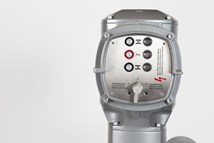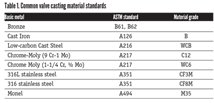How Much Carbon Can 3D-Printed Valve Components Save?
Additive manufacturing is often assumed to be more sustainable than subtractive production but there has been relatively little evidence to support that claim — until now.
#controls #components

Valve replacement components additively manufactured by IMI Retrofit3D. Source: IMI
Valves are inherently functional. Because of this, it can be easy to overlook their role in “big picture” issues such as climate change. But there’s good reason to make the connection and take it seriously.
Heavy industry, such as refining and chemical processing, is facing growing pressure to decarbonize across the value chain. Research shows that much of this pressure is now coming directly from customers.1
Valves in good working order also have a major impact on plant performance. According to the European Sealing Association, the nonprofit trade association representing manufacturers of sealing devices and materials, control valves account for roughly 60% of a plant’s total emissions. In refineries, this value can increase to 70%, though may only come from 1% of a facility’s total installed assets.2
These figures are enough for any facility to take action, which is partly why far more attention is now being given to fugitive emissions. But scrutiny cannot end there because other hidden issues have a major impact on the sustainability of heavy industry.
Take valve replacement scenarios. Every site, regardless of what’s being produced, needs to regularly maintain, upgrade or change its control valves at some point. This regularity comes with a carbon penalty. With advances to manufacturing techniques, however, there is now scope to drive down embodied carbon, to the point where considerable savings can be made by making relatively minor changes.
This situation provided the rationale for a life cycle assessment conducted by Ricardo on behalf of IMI. While important intelligence for IMI, the findings also have wider implications for the valve industry and industrial businesses seeking to drive down emissions in line with major targets.
Why analyze valve maintenance in such detail?
Valves can be damaged due to the harsh conditions, caustic substances and particles commonly observed in industrial flow control applications. Cavitation is among the most common of these issues and occurs with improper fluid velocity control.
Cavitation in a control valve is damaging, resulting in a potential loss of control and the frequent replacement of spare parts. It can create excessive noise, the erosion of metal parts and pressure fluctuations that result in valve or piping vibration and potentially fatigue failure.
When these issues occur, facilities must either repair and replace valve parts or the entire valve itself. Repairs typically involve engineers fitting a new disk stack. Full valve replacement is only needed if the valve’s body is damaged, or when a facility’s process conditions change.
Like-for-like replacement of core internal components is no guarantee of long-term success. This is especially true if the maximum flow velocity isn’t initially managed within the valve, or if the original valve trim is no longer suitable for the current process requirements.
Disk stacks constitute part of a recommended spares program, allowing a site to operate with minimal downtime. These stacks need replacing more often when fluid velocity control is not maintained, or when a site has an older, poorly designed control valve installed. These valves also wear naturally over time, making it essential to have an adequate maintenance program in place.
Suppliers and manufacturers work regularly with customers across the globe to replace faulty valves. As with any effort on this scale, this work has a significant impact on the environment and needs to be measured accurately to ensure that manufacturers are making legitimate progress on their own climate commitments, as well as those of their customers.
What did the life cycle assessment cover?
Ricardo’s lifecycle assessment examined the replacement of a faulty disk stack in a valve manufactured by IMI. The study assessed a large valve (8-in.) and a small valve (3-in.) across three different replacement scenarios:
1. Replacement of disk stack only via traditional manufacturing methods
2. Replacement of the full valve via traditional manufacturing methods
3. Replacement of the disk stack only via additive manufacturing
Full valve replacement included replacing the disk stack, body and bonnet, while the other two replacement scenarios only involved changes to the disk stack.
The lifecycle assessment was a cradle-to-grave study. However, the valve’s use phase was excluded because data was not available to support claims that different replacement scenarios have different use efficiency savings. Therefore, the study only examined the sourcing and production of raw materials required for each replacement scenario, manufacturing inputs, the transport of parts between sites and the end-of-life fate of finished parts, including transportation to a disposal location.
Setting the metrics
There are several ways to measure the environmental impact of a product or industrial process. Climate change impact (also known as global warming potential and abbreviated CCP and GWP, respectively) is arguably the most significant. Carbon dioxide equivalent (CO2-eq) is a metric measure used to compare the emissions from various greenhouse gases on the basis of their CCP/GWP.3 CO2-eq is the principal metric given in Ricardo’s final report.
Disk stacks, which can be either traditionally or additively manufactured, require different levels of maintenance and yield different lifetimes. This means that under a specific replacement scenario, a valve can last a certain time before it needs to be replaced or upgraded.
| Number | Replacement scenario | Replacement part(s) | Lifetime (yrs) | Number of lifetime replacements (yrs) |
|---|---|---|---|---|
| 1 | Traditional disk stack | Disk stacks only | 1 | 10 |
| 2 | Full valve replacement | Body, bonnet and traditional disk stack | 10 | 1 |
| 3 | Additive disk stack | Disk stack only | 5 | 2 |
IMI set the project’s horizon at 10 years. The table, Figure 1, shows the number of replacements required over that period for each replacement scenario.
As the organization procuring the study, IMI had to make some assumptions based on existing knowledge in this field, which were supplied to Ricardo. The table above provides a breakdown of the three replacement scenarios covered in this study.
As the table shows (Fig. 1), a traditionally manufactured replacement disk stack is assumed to last one year. Any facility using this replacement scenario would therefore need 10 new disk stacks over the set study horizon of 10 years. The full valve replacement is only required once, while disk stacks manufactured additively would need replacing twice over the 10-year period.
The researchers factored in these differences when analyzing the replacement scenarios as part of a sensitivity study, provided in the appendix of its report.
The additive advantage
Ricardo’s lifecycle assessment found that the additive disk stack replacement was the preferable scenario across all the environmental indicators analyzed. This finding was the same for both the large and small valve categories used in the study.
In other words, additively manufactured disk stacks should be considered environmentally advantageous when compared with the other valve replacement methods. This is due to the different materials used and the lower quantities needed to produce them.
The small valve with an additive disk stack replacement had a climate change impact of 146 kg of CO2-eq, while the large valve with an additive disk stack replacement recorded 1,360 kg CO2-eq. Both of these figures were calculated based on the 10-year study horizon.
For the large valve, this represented:
• A 96% climate change impact saving when compared with replacement of the full valve via traditional manufacturing.
• A 94% climate change impact saving when compared with replacement of the disk stack only via traditional manufacturing.
For the small valve, this represented:
• An 87% climate change impact saving when compared with replacement of the full valve via traditional manufacturing.
• An 85% climate change impact saving when compared with replacement of the disk stack only via traditional manufacturing.
Unsurprisingly, for the large valve, the least favorable scenario in terms of climate change impact was replacement of the full valve at 34,000 kg CO2-eq. This was due to the body component, which required more material and resources ahead of delivery to a customer site.
For the small valve results, however, the traditional disk stack replacement was the least favorable option. It contributed 1,130 kg CO2-eq. This is noticeably more than the 988 kg CO2-eq for the full valve replacement. This was due to the raw materials required for replacing 10 traditional disk stacks over the 10 years.
Extra work was carried out to determine the sensitivity of these results against assumptions made about the mode of transport, valve lifetimes and the frequency of replacement. Even with these factors, the additive replacement scenario still proved favorable.
Consideration was also given to assumptions about the frequency of replacements. Even with a “”tipping point” factored into the results, the additive disk stack still outperformed the other two scenarios. It was determined that an additive disk stack would need to be replaced every two or three months to be less favorable than the traditional replacement options.
1 https://www.pwc.com/gx/en/issues/esg/decarbonising-value-chain.html
2 ESA European sealing assoc. Pub. No. 014/05
3 https://ec.europa.eu/eurostat/statistics-explained/index.php?title=Glossary:Carbon_dioxide_equivalent
Editor’s note: As standards organizations evaluate the safety, reliability and compliance aspects of additive manufacturing of valve and valve components, this study clearly found that additively manufactured parts can offer time and cost savings to valve users.

Bertrand Maillon uses his extensive experience in product development and manufacturing at IMI, where he leads the Retrofit3D team. Retrofit3D addresses complex customer challenges with custom-made valve trim solutions made using the latest additive manufacturing techniques. Bertrand champions digital production as a gamechanger for reducing carbon footprints and reimagining supply chains.
RELATED CONTENT
-
The Diverse Role Valves Play in the Chemical Industry
The chemical industry is extremely diverse with more than 60,000 known products. Like all process industries, the chemical industry needs valves designed for safe, efficient and reliable process operation.
-
The Role of Valves in HAZOP Studies
Process hazard analysis (PHA) is required by U.S.
-
New Technologies Solve Severe Cavitation Problems
An advanced anti-cavitation control valve design enabled by 3D metal printing solved a power plant’s severe cavitation problem and dramatically improved its bottom line.







 Unloading large gate valve.jpg;maxWidth=214)


